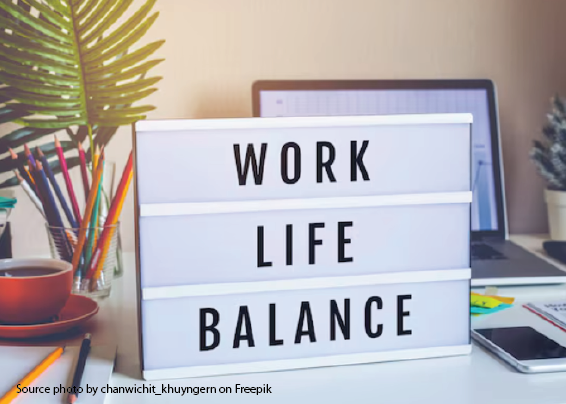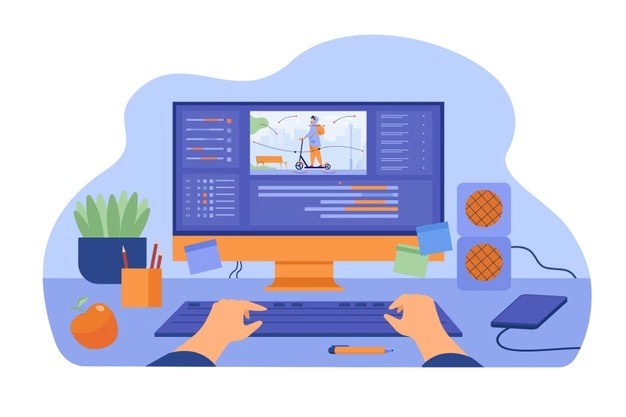WORK-LIFE BALANCE OF JEMBER UNIVERSITY LECTURERS

Downloads
Background: Work-life balance is a condition that occurs when the demands of work and the demands of personal life are balanced. Previous research stated that work-life balance for lecturers was achieved during the Work-from-Home (WFH) or online learning. However, it is known that the current learning system has returned to the offline system. Purpose: The purpose of the research was to determine factors of work-life balance among Jember University lecturers. Method: This type of research is observational analytics using a cross-sectional research design. The instrument used in the research was a work-life balance questionnaire developed by Fisher. The population for this research was 376 Jember University lecturers who were actively teaching. 128 respondents were taken as the sample. Sample selection in the research used a proportional random sampling technique and used the contingency coefficient and Chi-square statistical test. Result: The results showed that most respondents were male (54.7%), aged 28 to 46 years (64.1%), married (91.4%), had ≤2 children (62.5%), had functional positions of lectors (35.2%), had no structural positions (59.4%), and had no side jobs (68.8%). There was no significant relationship between sex (0.252), age (0.502), marital status (0.682), number of children (0.145), functional positions (0.312), structural positions (0.509), and side jobs (0.094) with work-life balance. Conclusion: Demographic and job characteristics do not affect the work-life balance among lecturers at University of Jember.
Afrianty, T.W., 2013. Work Life Balance Policies in the Indonesian Context (Thesis). Curtin University, School of Management Curtin Business School.
Amazue, L.O., Onyishi, I.E., 2016. Stress Coping Strategies, Perceived Organizational Support and Marital Status as Predictors of Work–Life Balance among Nigerian Bank Employees. Soc Indic Res Vol. 128(1), Pp. 147-159.
Arenofsky, J., 2017. Work–Life Balance. ABC-CLIO, California.
Ariono, P.A., Istiqomah, E., Hidayatullah, M.S., 2020. Hubungan Persepsi Tuntutan Kerja dengan Kecerdasan Emosional pada Dosen di Univesitas Lambung Mangkurat. Jurnal Kognisia Vol. 1(1), Pp. 8-103.
Basak, S., 2022. Work-Life Balance of Female University Teachers during COVID-19 Pandemic in Bangladesh. European Journal of Business and Management Vol. 14(4), Pp.68–79.
Bataineh, K., 2019. Impact of Work-Life Balance, Happiness at Work, on Employee Performance. International Business Research Vol. 12(2), Pp. 99-112.
Bejtkovsky, J., 2016. The Employees of Baby Boomers Generation, Generation X, Generation Y and Generation Z in Selected Czech Corporations as Conceivers of Development and Competitiveness in Their Corporation. Journal of Competitiveness Vol. 8(4), Pp. 105-123.
Benson, N.M., Beach, S.R., 2019. After Hours: A Survey of Moonlighting Practices in Psychiatry Residents. Acad Psychiatry Vol. 43(1), Pp.18-22.
Bhadana, J., Saxena, N., Bhatia, A., 2022. Uttar Pradesh Academics’ Occupational Stress, Organisational Work Environment and Work-Life Balance: A Quantitative Study. SA Journal of Human Resource Management Vol. 20, Pp. 1-8.
Caza, B.B., Moss, S., 2015. When Work Satisfaction Comes from Having 4 Jobs. Harvard Business Review.
Chandrasekar, K.S., S R, S., Nair, R., R, A., 2013. Study on Work - Life Balance among The Execu- Tives in It Industry with Special Reference to Techno Park. AJMR Vol. 2(3), Pp. 35-52.
Clemen, N.M., Blacker, B.C., Floen, M.J., Schweinle, W.E., Huber, J.N., 2018. Work-Life Balance in Women Physicians in South Dakota: Results of a State-Wide Assessment Survey. S D Med Vol. 71(12), Pp. 550-558.
Dara, D., Eliyana, A., Hamidah, H., 2020. The Engagement and Working Satisfaction of Millennial Lecturers During the COVID-19 Pandemic: Differences in Gender Identity Perspectives. Systematic Reviews in Pharmacy Vol. 11(10), Pp. 438-445.
Datin BPKH UNEJ, 2022. Kepegawaian (Layanan). Jember University.
Diego-Medrano, E., Ramos Salazar, L., 2021. Examining Work-Life Balance of Faculty in Higher Education. ICPK Vol. 3(3), Pp. 27-36.
Dilly, A., 2019. Sikap dan Coping Strategy pada Profesional Wanita Menghadapi Konflik Pekerjaan-Keluarga. Jurnal Hibualamo: Seri Ilmu-ilmu Sosial dan Kependidikan Vol. 3(2), Pp. 1-9.
Elvandari, M., Briawan, D., Tanziha, I., 2016. Hubungan Asupan Zat Gizi dan Serum Retinol dengan Morbiditas pada Anak 1-3 tahun di Jawa Tengah. Jurnal MKMI Vol. 12(4), Pp. 201-2017.
Eurostat, 2021. Self-Reported Work-Related Health Problems and Risk Factors - Key Statistics - Statistics Explained. Eurostat Statistic Explained. URL https://ec.europa.eu/eurostat/statistics-explained/index.php?title=Self-reported_work-related_health_problems_and_risk_factors_-_key_statistics (accessed 12.7.23).
Fapohunda, T., 2014. Gender Influences in Work Life Balance: Findings from Nigeria. Global Journal of Human Resource Management Vol. 2(2), Pp. 25-39.
Fattah, H., Nursyamsi, I., Munir, A.R., Lasise, S., 2020. Aktivitas Moonligthing terhadap Kinerja Dosen. YUME : Journal of Management Vol. 3(3), Pp.106-114.
Fishman, A.A., 2016. How Generational Differences will Impact America’s Aging Workforce: Strategies for Dealing with Aging Millennials, Generation X, and Baby Boomers. Strategic HR Review Vol. 15(6), Pp. 250-257.
Hobfoll, S.E., 1989. Conservation of Resources: A New Attempt at Conceptualizing Stress. American Psychologist Vol. 44(3), Pp. 513-524.
Husin, N.A., 2018. Work-life Balance of Malaysian Lecturers. Australian Academy of Business and Economics Review (AABER) Vol. 4(1), Pp. 43-49.
Johnston, K., Tanwar, J., Pasamar, S., Van Laar, D., Bamber Jones, A., 2022. Blurring Boundaries: Work-Life Balance and Unbounded Work in Academia. The Role of Flexibility, Organisational Support and Gender. Labour and Industry Vol. 32(2), Pp. 139-155.
Kahn, R.L., 1964. Organizational Stress, 1st ed. John Wiley & Sons.
Kaur, D., 2017. An Empirical Study on Work Life Balance of An Employee With Special Reference to Telecom Sector (Thesis). S. Peter’s University Chennai, Dept of Management Studies.
Kotera, Y., Green, P., Sheffield, D., 2019. Work-Life Balance of UK Construction Workers: Relationship with Mental Health. Construction Management and Economics Vol. 38(4), Pp. 1-40.
Kristina, 2022. Aturan Kuliah Tatap Muka TA 2022/2023, Dirjen Dikti: Semakin 100 Persen (Perguruan Tinggi).
Kumar, K., Chaturvedi, R., 2018. Work-Life Balance and Job Satisfaction from the Perspective of Multiple Job Holding Women: Comparative Analysis of Generational Cohorts. International Journal of Advances in Management and Economics Vol. 6(5), Pp. 32-40.
Lendák-Kabók, K., 2022. Women’s Work–Life Balance Strategies in Academia. Journal of Family Studies Vol. 28(3), Pp. 1139-1157.
Liu, D., Wu, Y., Jiang, F., Wang, M., Liu, Y., Tang, Y.-L., 2021. Gender Differences in Job Satisfaction and Work-Life Balance among Chinese Physicians in Tertiary Public Hospitals. Front Public Health Vol. 9, Pp. 635260.
Lyness, K.S., Judiesch, M.K., 2014. Gender Egalitarianism and Work–Life Balance for Managers: Multisource Perspectives in 36 Countries. Applied Psychology Vol. 63(1), Pp. 96-129.
Magadley, W., 2021. Moonlighting in Academia: A Study of Gender Differences in Work-Family Conflict among Academic. Community, Work & Family Vol. 24(3), Pp. 237-256.
Mahani, D., Ma’rufi, I., Indrayani, R., 2020. Beban Kerja Mental dan Pendapatan dengan Kebahagiaan di Tempat Kerja Pada Dosen di Universitas Jember. IKESMA Vol. 16(1), Pp. 16.
Marhamah, F., Erwansyah, E., Natsir, N., Hamrun, N., Asdar Gani, Irwan, A.F., Achmad, H., 2020. Bad Habits in Children and Their impact on Oral Health and Development of Teeth. IJPR Vol. 12(SP2).
Mitra, S., Chakraborty, A.J., Tareq, A.M., Emran, T.B., Nainu, F., Khusro, A., Idris, A.M., Khandaker, M.U., Osman, H., Alhumaydhi, F.A., Simal-Gandara, J., 2022. Impact of Heavy Metals on The Environment and Human Health: Novel Therapeutic Insights to Counter The Toxicity. Journal of King Saud University - Science Vol. 34(3), Pp. 101865.
Musa, N., Hakiem, M., Deski, A., Shofyan, M., Sabilia, A., Chusairi, A., 2022. Studi Fenomenologi: Work Life Balance pada Dosen Wanita selama Pandemi COVID-19. Jurnal Abdi Insani Vol. 9(2), Pp. 419-427.
Neville, K.M., Brochu, K., 2019. Work–Life Balance: The Generational Divide. About Campus Vol. 24(4), Pp. 21-24.
Okiko, Lynet, 2020. Mediating Effects of Moonlighting on the Relationship between Job Design and Compensation on Job Performance and Work-Life Balance in Selected Universities in East Africa: Basis for Proposed Policies in Moonlighting - ProQuest (Dissertation). Adventist University of the Philippines, Doctor of Philosophy in Commerce Major in Human Resource Management.
Padmasiri, D., Mahalekamge, G., 2016. Impact of Demographical Factors on Work Life Balance among Academic Staff of University of Kelaniya, Sri Lanka. Journal of Education and Vocational Research Vol. 7(1), Pp. 54-59.
Panisoara, G., Serban, M., 2013. Marital Status and Work-life Balance. Procedia - Social and Behavioral Sciences, PSIWORLD 2012 Vol. 78, Pp. 21-25.
Poulose, S., N, S., 2014. Work Life Balance: A Conceptual Review. International Journal of Advances in Management and Economics Vol. 3(2), Pp. 1-17.
Prasetyo, Y.D., 2022. Pengaruh Otonomi Kerja, Beban Kerja dan Work-Life Balance terhadap Kinerja Pejabat Fungsional Badan Pendidikan dan Pelatihan Keuangan dengan Kepuasan Kerja sebagai Variabel Intervening. JMB : Jurnal Manajemen dan Bisnis Vol. 11(1), Pp. 47-56.
Putra, A.R., Darmawan, D., 2022. Pencapaian Efektivitas Kerja Melalui Optimalisasi Kecerdasan Emosional dan Pemberian Beban Kerja secara Tepat pada Karyawan. Jurnal Baruna Horizon Vol.5, Pp. 8–16.
Putra, R.S., 2021. Work Life Balance pada Pejabat Wanita yang Ada di Salah Satu Universitas di Indonesia. Ecopreneur.12 Vol. 3(2), Pp. 119-128.
Rahmawati, Z., Gunawan, J., 2020. Hubungan Job-Related Factors, Work-life Balance dan Kepuasan Kerja pada Pekerja Generasi Milenial. Jurnal Sains dan Seni ITS Vol.8(2), Pp. D418-D423.
Regulation of the Minister for Administrative Reform and Bureaucratic Reform, 2013. Permen PAN & RB No. 17 Tahun 2013.
Riffay, A., 2019. Pengaruh Keseimbangan Kehidupan Kerja (Work Life Balance) dan Kepuasan Kerja terhadap Komitmen Organisasi Guru SD Negeri di Kecamatan Kota Masohi. Jurnal Ilmiah Wahana Pendidikan Vol. 5(3), Pp. 39-47.
Sirgy, M.J., Lee, D.-J., 2018. Work-Life Balance: An Integrative Review. Applied Research in Quality of Life Vol. 13, Pp. 229-254.
Soelton, M., Ketaren, G.P., Oktaviar, C., Wahyono, T., Imaningsih, E.S., Saratian, E.T.P., 2021. Apakah Employee Engagement yang Baik Dipengaruhi Keseimbangan antara Kecerdasan Emosional, Beban Kerja dan Work Life Balance? Conference on Economic and Business Innovation (CEBI) Vol. 1(1), Pp. 154-1167.
Starmer, A.J., Frintner, M.P., Matos, K., Somberg, C., Freed, G., Byrne, B.J., 2019. Gender Discrepancies Related to Pediatrician Work-Life Balance and Household Responsibilities. Pediatrics Vol. 144(4), Pp. e20182926.
Subramaniam, G., Ramachandran, J., Putit, L., Raju, R., 2020. Exploring Academics’ Work-Life Balance and Stress Levels using Flexible Working Arrangements. Environment-Behaviour Proceedings Journal Vol. 5(15), Pp. 469-476.
Tomer, G., Xanthakos, S., Kim, S., Rao, M., Book, L., Litman, H.J., Fishman, L.N., 2015. Perceptions of GenderEquality in Work-Life Balance, Salary, Promotion,and Harassment: Results of The NASPGHAN TaskForce Survey. J Pediatr Gastroenterol Nutr Vol. 60(4), Pp. 481-485.
Walia, P., 2015. Gender and Age as Correlates of Work-Life Balance. Journal of Organization and Human Behaviour Vol. 4(1).
Yuliantini, E., 2018. Konsumsi Serat, Kalium dan Hubungannya dengan Kadar Low Density Lipoprotein (LDL) Pasien Penyakit Jantung Koroner. Jurnal Media Kesehatan Vol. 9(1), Pp. 84-88.
Copyright (c) 2024 Journal of Vocational Health Studies

This work is licensed under a Creative Commons Attribution-NonCommercial-ShareAlike 4.0 International License.
- The authors agree to transfer the transfer copyright of the article to the Journal of Vocational Health Studies (JVHS) effective if and when the paper is accepted for publication.
- Legal formal aspect of journal publication accessibility refers to Creative Commons Attribution-NonCommercial-ShareAlike (CC BY-NC-SA), implies that publication can be used for non-commercial purposes in its original form.
- Every publications (printed/electronic) are open access for educational purposes, research, and library. Other that the aims mentioned above, editorial board is not responsible for copyright violation.
Journal of Vocational Health Studies is licensed under a Creative Commons Attribution-NonCommercial-ShareAlike 4.0 International License

























































